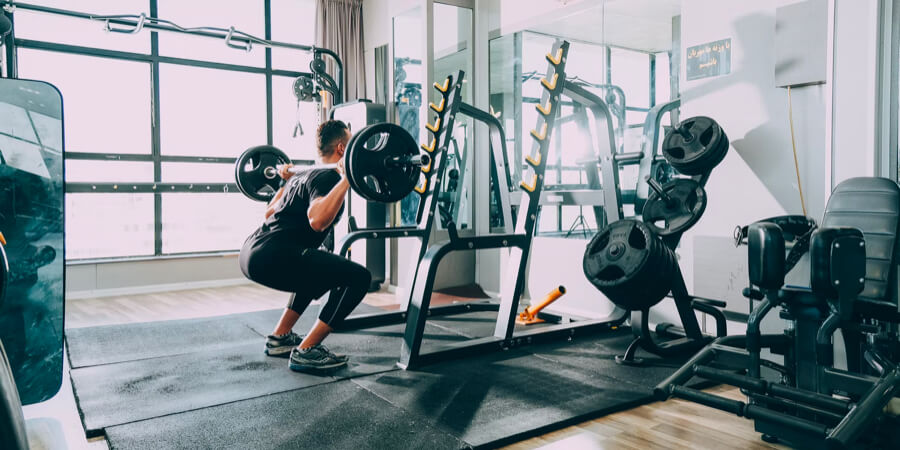The New Year is a great time to start focusing on your health and fitness goals. Part of your plan for achieving these goals may include joining a gym, working with a personal trainer or attending fitness classes. While fitness and wellness centers are starting to open up in many areas of the country and some are offering fitness classes, personal training and other fitness activities, you may be concerned about whether it is safe to join or return to these facilities due to the risk for COVID-19 transmission.
When weighing your options, it is important to consider both the risks associated with exercising at an indoor gym and steps you can take to keep yourself safe.
It can be helpful to understand some of the risks associated with exercising at an indoor gym:
- Air droplets can travel farther during exercise: The recommendation by the Centers for Disease Control and Prevention is to maintain social distancing of at least six feet from other individuals to avoid inhalation of virus-containing respiratory droplets. When someone is exercising, they breathe with more force than while at rest. Therefore, heavier breathing during exercise can result in an increased concentration of air droplets traveling farther, thus increasing the risk for COVID-19 transmission.
- It is difficult to maintain social distance at all times at the gym: While many fitness facilities are following guidelines by spacing out equipment and encouraging social distancing, you may find yourself in a situation where another member decides to exercise on the cardio machine next to you or several members are having a conversation right next to where you are completing your set of bench presses. Even with limits to facility numbers, weight rooms and cardio areas can get crowded, making it more difficult to maintain social distancing throughout your workout.
- Inadequate air ventilation: Some fitness and wellness centers may not have ventilation systems that can adequately remove viral droplets and particles from the air, thus increasing members’ risk of infection, especially in smaller indoor spaces.
- Using shared equipment: While COVID-19 is most commonly spread through close contact with an individual who has the virus, it is possible to become infected by touching a contaminated surface and then touching your mouth, nose or eyes. Therefore, using shared equipment such as weight and cardio machines, mats, or dumbbells that are not cleaned before and after each use may increase your risk for COVID-19.
Now that you have a better understanding of the risks, here are some ways to mitigate that risk and keep yourself safe at your fitness facility:
- Choose a gym where you feel comfortable and safe: Fitness and wellness facilities must follow state guidelines; however, some may take more precautions than others, such as implementing additional temperature and symptom assessments, cleaning and mask-wearing protocols and limited fitness class sizes. Therefore, visit a few different facilities and join the one where you will feel safe and comfortable to exercise. It may be beneficial to choose a facility that also offers online personal training, virtual fitness classes, and/or outdoor classes so that you can create a weekly exercise routine that includes workouts that take place at the gym, outside and at home to limit the number of times per week that you are exercising at an indoor gym.
- Wear a mask that covers your mouth and nose while exercising: Although it may be uncomfortable to exercise with a mask, it can help keep you and others safe from COVID-19. Also, a recent study found that heart rate, blood pressure, respiratory rate and oxygen saturation were not adversely impacted in healthy individuals who performed aerobic exercise while wearing a mask. When exercising with a mask, it can be helpful to bring several disposable masks and change them throughout the workout.
- Maintain social distancing: Maintain social distancing of at least 6 feet to avoid close contact with other facility members or employees. Work out in areas of the gym that are less crowded and avoid attending the gym during peak hours.
- Bring your own equipment: When possible, bring your own equipment such as mats, dumbbells or bands to use during your workout or when attending fitness classes.
- Bring your own water bottle: Some fitness facilities may not allow access to water fountains. Therefore, bring your own water bottle to make sure you have safe access to water.
- Clean equipment before and after use: Clean each piece of equipment before and after you use it, and avoid touching your mouth, nose and eyes throughout your workout.
- Wash hands before and after your workout: Wash your hands before and immediately after your workout with soap and water.
- Limit indoor high-intensity exercise: When possible, perform high-intensity activities outdoors. If performing high-intensity exercise indoors, increase distance.
Beginning or maintaining an exercise routine is paramount for both physical and mental health and it is especially important during this health crisis. Make sure you choose a place and format that will best support your health-related goals and level of comfort for safely starting or returning to an active lifestyle.
Exercising at a gym or fitness facility, outdoors, or from the comfort of your home can help maintain a healthy lifestyle, and taking appropriate precautions can reduce the risk of COVID-19 transmission in all settings. What is most important is that you find a way to safely keep moving during these challenging times to stay focused on your health and fitness goals.
Via: www.acefitness.org




